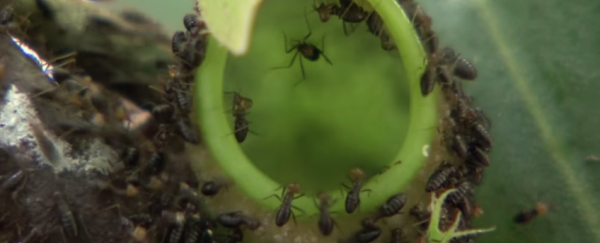
We've said it before and we'll say it again: if something seems too good to be true, it probably is. Take the pitcher plant, for example, which entices insects by the thousands to feed on the sweet nectar it spills out all over the place. But before they can actually enjoy all that nectar, the insects will slip on it and fall into a deadly pool of acid at the bottom of the pitcher plant's bucket-shaped leaf. And as this newly released Smithsonian footage so horrifyingly reveals, that acid pool can quickly become a mass termite grave, with the plant capable of digesting more than 6,000 insects in an hour.
It all sounds (and looks) pretty traumatic, but it's actually a pretty clever strategy. Unlike other carnivorous plants, which need to snap shut on their prey, the pitcher plant just has to sit there looking appetising and collects enough insects to feed it for days. These insects are broken down in a pool of digestive acids and rainwater that sits at the bottom of the pitcher, eventually becoming a nutrient soup that sustains the plant.
Pitcher plants belong to the Nepenthaceae and Sarraceniaceae families, and are found pretty much all over the world in areas of high rainfall. This video shows the white-collared pitcher plant, which is native to South East Asia and is unique because it specifically lures only termites to its nectar. And it clearly excels at what it does if this video is anything to go by.
We don't want to spoil the gory finale, so check out the footage above to see one of nature's most efficient killers in action. If you've ever battled with termites on your property before, you'll probably find the whole thing slightly satisfying.
And if you're really interested, check out a dissection of a pitcher plant stomach below. Warning: it's NSFW (not safe for wasps).

